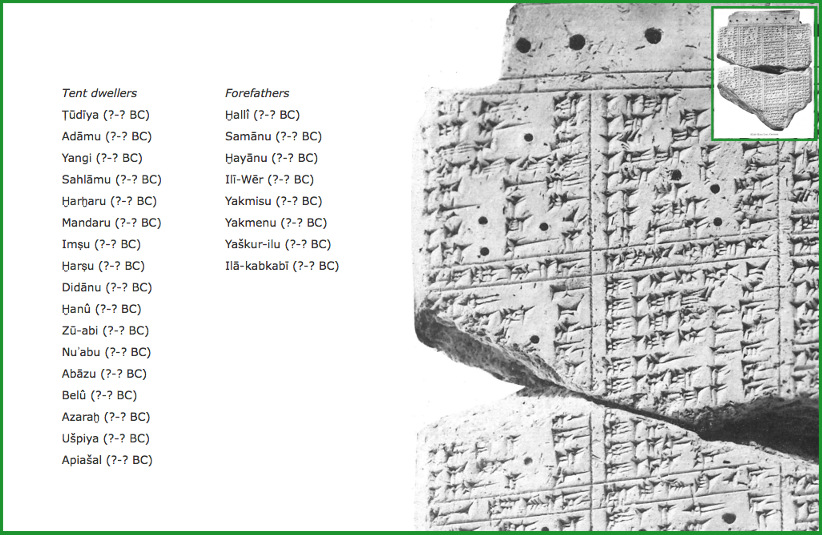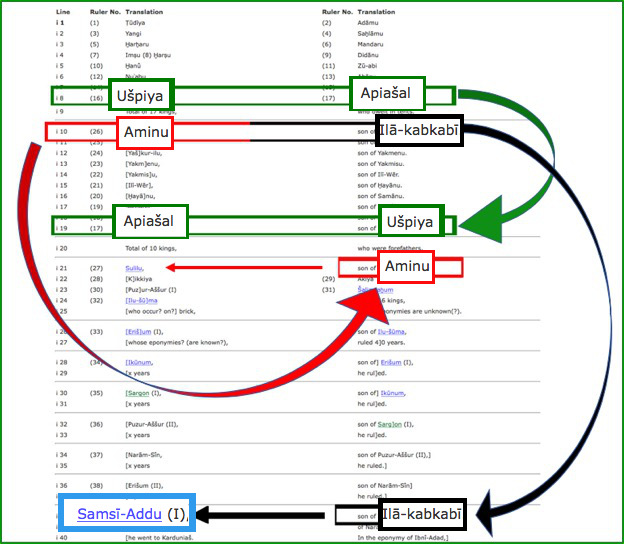The seventeen rulers who "dwelt in tents" and Samsī-Addu's forefathers
According to the Assyrian King List [/riao/KingLists/AssyrianKingList/index.html] (AKL), there were seventeen rulers who "dwelt in tents [/riao/KingLists/AssyrianKingList/index.html#Tent-dwellers]"; these men were said to have then been followed by nine tribal ancestors ("forefathers") of Samsī-Addu I (ca. 1808-1776 BC). These men were:

These first two sections of the AKL, together with the next two [/riao/KingLists/AssyrianKingList/AssyrianKingList/index.html#Sulilu_KL] ("Rulers whose eponyms are not known," nos. 27-32, and the Old Assyrian rulers up to Samsī-Addu I, nos. 33-39), are the result of the first editorial stage [/riao/KingLists/AssyrianKingList/index.html#Note2Yamada] (or Grundstock) in the complex process that shaped the list; the main purpose was to create a fictitious pedigree for the usurper Samsī-Addu that would certify his bond with the city of Aššur and legitimize his rule.
The artificial nature of these four sections required some contrivance to appear more historically coherent. Most notable are two stragems employed to harmonize the different parts of the list: the repetition of two names, Ušpiya (16) and Apiašal (17), in the first and second sections; and the anachronistic attribution of Sulilu (27) and Samsī-Addu I (38) to the same generation through their relationship to Ilā-kabkabī.
Tent dwellers
The first seventeen rulers listed in the AKL are defined as šarrāni ašibutu kultari "kings who dwelt in tents." This is the only segment of the AKL to have no chronological arrangement of any sort, except for the sequence of names, which only in the case of Ušpiya and Apiašal seems to follow, according to the next section, actual succession.
Finkelstein noted a strong connection between the so-called "Genealogy of the Hammurapi Dynasty" (BM 80328, from here on referred to as GHD) and the AKL, especially the SDAS [/riao/KingLists/AssyrianKingList/SDASList/index.html] version, which, because of its line arrangement, is the closest version to a hypothetical original source. Comparing the first lines of the two texts, the first three names of unusual length in the GHD can be explained as "fused forms of the names of two persons" that, once separated, are almost identical to three pairs of names in the AKL, and are listed in almost the same order. A further comparison between the first seventeen rulers of the AKL and those of the first nineteen lines of the GHD likewise shows a striking resemblance between at least nine (and possibly as many as eleven) names from both lists (Finkelstein 1966:97-103).
| AKL (SDAS arrang.) (ruler no.) | GHD (line no.) |
|---|---|
| (1) Ṭūdīya (2) Adāmu | (2) Tu-ub-ti-ya-mu-ta |
| (3) Yangi (4) Saḫlāmu | (3) Ya-am-qú-us-sú-ḫa-lam-ma |
| (5) Ḫarḫaru (6) Mandaru | (1) A-ra-am-ma-da-ra |
| (7) Imṣu/Aḫiṣu (8) Ḫarṣu (9) Didānu | (5) Nam-zu-ú (6) Ditānu |
| (10) Ḫanû (11) Zū-abi/Sumabu | (4) Ḫeana (7) Zummabu |
| (12) Nuʾabu (13) Abāzu | (8) Namḫu |
| (14) Belû (15) Azaraḫ | |
| (16) Ušpiya (17) Apiašal |
These similarities, added to the presumed tribal origin of the names and to the presence of rhymed pairs of names (see below), suggest that the first sections of the AKL and the GHD are based on an earlier text, possibly transmitted orally (a "desert chant," as Finkelstein calls it), and common to the traditions of the nomadic tribes of early Mesopotamia. The creation of a group of (Amorite) ancestors in common with the people of Aššur, makes this (coupled with the following Forefathers section) the core of the process of legitimizing Samsī-Addu I (Finkelstein 1966:112-3). That this brilliant literary undertaking must have been at the center of lively disputes, which continued even after the end of Samsī-Addu's reign, is testified by the only surviving inscription of one of his successors(?), Puzur-Sîn (whose reign is not mentioned in the AKL), which denounces Samsī-Addu's foreign origins in order to delegitimize his rule.
"Forefathers" and editorial work
The Forefathers section stands on much firmer historical ground. Scholars have commonly agreed that the names listed here are the forefathers of Samsī-Addu I (Yamada 1994:15). Confirmation for this can be found in the Mari Eponym Chronicle (from the period of Samsī-Addu), in which two names from this section of the AKL, namely Ilā-kabkabī and Aminu, appear as predecessors of Samsī-Addu. The Forefathers section possibly presents, then, a chronological (although doubtfully a mono-dynastical) list of previous heads of Samsī-Addu's family in the form of a fictitious pedigree of Aminu.
A peculiarity of this segment of the list is that it is arranged in reverse chronological order, starting with Aminu, son of Ilā-kabkabī, and going back in time from son to father until the reiteration of Apiašal, son of Ušpiya. The reasoning behind the authors' decision to reverse the chronology remains obscure. However, we do notice that this series of narrative devices (in the repetition of names) and visual devices (in the position of the names on the tablet) combine to express the gradual transition from the non-chronological, ancestral time of the tent dwellers to the standardized, documents-based period that begins with the reign of Erišum I.
From the point of view of both the chronology and of the creation of an ancestral past that links Samsī-Addu to the city of Aššur, the first four sections of the AKL can be compared to the palū (of the Amorites, the Ḫaneans, and the Gutians) of the GHD, as interpreted by Finkelstein. That is, they do not describe regnal years, but "three successive 'ages' or 'eras' or 'dynasties'" (1966:106).
In the AKL, each one of the first four sections is successively more grounded on chronological principles and more bound to the history of Aššur than the previous one. Furthermore, the four sections have been harmonized to one another through the intermingling of the names that - because of the reverse chronological arrangement found in the Forefathers section - either are, or appear to be, repeated, always in alternating positions.
Section 1. [/riao/KingLists/AssyrianKingList/AssyrianKingList/index.html#Tent-dwellers] "seventeen kings who dwelt in tents": the names are listed without any chronological information; the list ends with (16) Ušpiya and (17) Apiašal.
Section 2. [/riao/KingLists/AssyrianKingList/AssyrianKingList/index.html#Forefathers] "forefathers": the names are listed along with information regarding filiation; of the names in this part of the list, Ušpiya and Apiašal are the only names that are known to the authors of the AKL to have had a certain (although chronologically dubious) bond with the city of Aššur. These names are repeated, but only at the end of the section, according to the reverse chronological order in which this section is written; instead, the list "starts" with "(26) Aminu, son of (25) Ilā-kabkabī."
Section 3. [/riao/KingLists/AssyrianKingList/AssyrianKingList/index.html#Sulilu_KL] (as reconstructed) "kings who(se names) appear on bricks, (but) whose eponyms are not known": the names bear no chronological information, except for the anachronistic filiation of (27) Sulilu son of (26) Aminu, which appears to visually alternate with its first appearance because of the reverse order of the previous section.
Section 4. [/riao/KingLists/AssyrianKingList/AssyrianKingList/index.html#Erishum_KL] from Erišum I to Samsī-Addu I: here the list is standardized, and strongly based on eponyms. The names move quickly towards the period of Samsī-Addu I, who is said to be son of Ilā-kabkabī and therefore linked to the line of rulers listed in the second and the third sections.
The level of chronological information both alternates and progressively increases. The first and third sections feature no chronological information, with the exception of (27) "Sulilu, son of Aminu." However, these two sections are chronologically harmonized to the second through links that visually alternate. The names of Ušpiya and Apiašal appear once at the end of the first section and a second time at the end of the second section (because of its reversed order). The second appearance of these names also includes filiation information, increasing the chronological datum. "Aminu son of Ilā-kabkabī" appears at the "beginning" of the Forefathers section – more chronologically grounded than the one before - and at the beginning of the third section, which, like the first section, lacks any kind of chronological information, but has a strong connection to the history of Aššur ("kings, whose names appear on bricks"). It is notable, here, that what would have been a standard repetition (RN2 son of RN1, RN3 son of RN2) takes the form, because of the reverse order (RN1 son of RN2, RN2 son of RN3), of an alternate repetition in chiasmatic sequence that (only in the SDAS list) reflects that of Ušpiya and Apiašal. Finally, Ilā-kabkabī appears as the father of Samsī-Addu I in the fourth section that is chronologically and Aššur-bound document-based, as the line of Erišum I also states (if the reconstruction "whose eponyms are known" is correct). A feature that might have been perceived as sufficiently historical to let the reader overlook the (clearly) fictitious filiation of Sulilu.

Notes on names
The following is a summary of all currently available information for some of the names from these two sections of the AKL:
Tent dwellers (1-17)
Kraus (1965, 4) sees Adāmu (2) as the only name in the tent-dwellers section to have any parallel from Akkadian personal names; none of the other names have either Assyrian or Akkadian parallels. He also suggests that Ṭūdīya (1), Ḫarḫaru (5), Imṣu (7), Ḫarṣu (8), Belû (14) are appellative, and could therefore be distortions of their original names. The presence of rhyming pairs of names is also suspicious: (2) Adāmu and (4) Saḫlāmu; (5) Ḫarḫaru and (6) Mandaru; (7) Imṣu/Aḫiṣu and (8) Ḫarṣu; 11) Zū-abi/Sumabu and (12) Nuʾabu.
Forefathers (16-26)
Selected Bibliography
Nathan Morello
Nathan Morello, 'The seventeen rulers who "dwelt in tents" and Samsī-Addu's forefathers', RIA 1: Inscriptions from the Origins of Assyria to Arik-dīn-ili, The RIA Project, 2024 [http://oracc.org/OldAssyrianPeriod/Forefathers/]